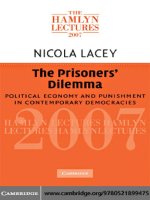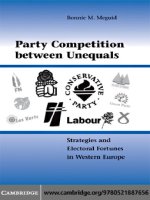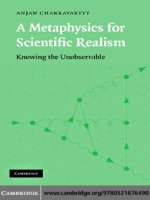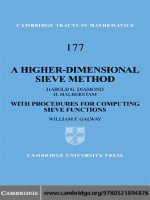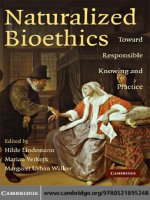0521807433 cambridge university press a critical introduction to law and literature apr 2007
Bạn đang xem bản rút gọn của tài liệu. Xem và tải ngay bản đầy đủ của tài liệu tại đây (1.36 MB, 273 trang )
This page intentionally left blank
A CRITICAL INTRODUCTION TO LAW
AND LITERATURE
Despite their apparent separation, law and literature have been closely
linked fields throughout history. Linguistic creativity is central to the
law, with literary modes such as narrative and metaphor infiltrating
legal texts. Equally, legal norms of good and bad conduct, of identity
and human responsibility, are reflected or subverted in literature’s
engagement with questions of law and justice. Law seeks to regulate
creative expression, while literary texts critique and sometimes openly
resist the law. Kieran Dolin introduces this interdisciplinary field,
focusing on the many ways that law and literature have addressed and
engaged with each other. He charts the history of the shifting relations
between the two disciplines, from the open affiliation between literature and law in the sixteenth-century Inns of Court to the less visible
links of contemporary culture. Each chapter is organized around close
analysis of a famous trial or literary-legal encounter. The wide resonance of such trials illuminates the cultural centrality of law, and the
social responsiveness of literature. This book provides an accessible
guide to one of the most exciting areas of interdisciplinary scholarship
today.
K I E R A N D O L I N is Senior Lecturer in English and Cultural Studies
at the University of Western Australia. He is the author of Fiction and
the Law: Legal Discourse in Victorian and Modernist Literature
(Cambridge, 1999).
A CRITICAL INTRODUCTION
TO LAW AND LITERATURE
KIERAN DOLIN
CAMBRIDGE UNIVERSITY PRESS
Cambridge, New York, Melbourne, Madrid, Cape Town, Singapore, São Paulo
Cambridge University Press
The Edinburgh Building, Cambridge CB2 8RU, UK
Published in the United States of America by Cambridge University Press, New York
www.cambridge.org
Information on this title: www.cambridge.org/9780521807432
© Kieran Dolin 2007
This publication is in copyright. Subject to statutory exception and to the provision of
relevant collective licensing agreements, no reproduction of any part may take place
without the written permission of Cambridge University Press.
First published in print format 2007
ISBN-13
ISBN-10
978-0-511-27350-6 eBook (EBL)
0-511-27350-9 eBook (EBL)
ISBN-13
ISBN-10
978-0-521-80743-2 hardback
0-521-80743-3 hardback
Cambridge University Press has no responsibility for the persistence or accuracy of urls
for external or third-party internet websites referred to in this publication, and does not
guarantee that any content on such websites is, or will remain, accurate or appropriate.
Contents
Preface
page vii
Introduction to law and literature: walking the boundary
with Robert Frost and the Supreme Court
PART I
1
EMINENT DOMAINS: THE TEXT OF THE LAW
AND THE LAW OF THE TEXT
17
1 Law’s language
19
2 Literature under the law
41
PART II
73
LAW AND LITERATURE IN HISTORY
3 Renaissance humanism and the new culture of contract
75
4 Crime and punishment in the eighteenth century
96
5 The woman question in Victorian England
6
The common law and the ache of modernism
120
143
7 Rumpole in Africa: law and literature in post-colonial society
166
8 Race and representation in contemporary America
182
Conclusion
207
Notes
Bibliography
Index
213
235
260
v
Preface
‘Poetry, like the law, is a fiction’, wrote William Hazlitt in a critical essay of
1816. Hazlitt the critic took as his subject all aspects of his society’s culture,
including the connections between law, literature and power. He analysed
the rhetoric of the lawyers and the legislative acts of politicians as products
of a legal imagination comparable with the literary imagination of the
poets. He examined the effects of those imaginings on the people, who
were subjects of the law as well as readers of literary fictions. With
characteristic forthrightness, he appended an aesthetic judgment to the
comparison: ‘Poetry, like the law, is a fiction; only a more agreeable one.’
This book shares the conviction that law and literature have common
properties of language and vision. In it I try to show how this connection
matters, how it works to shape a culture’s notions of justice and legal
entitlement. The first three chapters explore the bases for linking law and
literature; the next six present a historical account of shifts in their relationship in Anglophone culture from the Renaissance to the present.
In undertaking this study I have had the benefit of advice and support
from many colleagues at the University of Western Australia. I would
particularly like to thank Daniel Brown, Victoria Burrows, Tanya
Dalziell, Gareth Griffiths, Tony Hughes-d’Aeth, Judith Johnston, Gail
Jones, Andrew Lynch, Ian Saunders, Bob White and Chris Wortham. For
administrative support I am grateful to Sue Lewis and Linda Cresswell. I
would also like to acknowledge the pleasure and profit I have derived from
conversations with Michael Meehan, Penelope Pether, Simon Petch, Peter
Rush, Richard Weisberg and other Law and Literature scholars. Over
many years Hilary Fraser and Richard Freadman have provided inspiration
as well as guidance. My brother Tim Dolin has generously shared his great
critical acuity. However, the author accepts liability for any mistakes
herein.
It is a pleasure to acknowledge the financial support of an Australian
Research Council Discovery Grant, which funded time to write, research
vii
viii
Preface
assistance and travel to archives. My research assistants, Victoria Bladen,
Duc Dau and Catherine Johns, found an abundance of material and
offered accurate summaries and fruitful suggestions. I would also like to
thank my own university for the award of UWA Research Grants enabling
me to concentrate on this study through teaching relief. I have drawn
heavily on the resources of the Scholars’ Centre in the UWA Library and
would like to express my appreciation to Dr Toby Burrows, the Director,
and the staff there, for their efficiency and expert help. I wish to thank the
staff of the Bodleian Library, Oxford, for assisting me to make use of their
unrivalled collection.
I am deeply grateful to Cambridge University Press: to my editor, Ray
Ryan, for supporting this project from its inception, and for his encouragement and advice. I would also like to thank the assistant editor Maartje
Scheltens, and the readers of both the original proposal and the manuscript, whose suggestions were extremely helpful. For permission to reproduce the image on the cover, Hogarth’s The Bench, I am grateful to
the Syndics of the Fitzwilliam Museum, Cambridge. The following
material is reproduced by permission of the copyright holder: ‘Mending
Wall’ from The Poetry of Robert Frost, edited by Edward Connery Latham
# 1969. Reprinted by permission of Henry Holt and company, LLC.
My greatest debt is to my wife, Jane Courtney, for her love and good
counsel, and to our children, Patrick, Michael and Anna. Their love of
words and stories, their questioning of law (and literature) have been an
indispensable counterpoint to the writing of this book.
Introduction to law and literature: walking the
boundary with Robert Frost and the Supreme Court
In April 1995 the American Supreme Court decided the case of Plaut v.
Spendthrift Farm Inc.1 The case began in 1987 when Mr and Mrs Plaut and
some other investors in Spendthrift Farm alleged that it had committed
fraud and deceit when selling stock, contrary to Section 10(b) of the
Securities and Exchange Act of 1934. The District Court in Kentucky
held that this suit was time barred, following a recent Supreme Court
decision in the case of Lampf which declared that such suits must be
commenced within one year after the discovery of the facts constituting
the violation and within three years of the violation itself. After this judgment became final, Congress enacted a new Section 27A(b) of the
Securities and Exchange Act, providing that any action commenced before
Lampf, but dismissed thereafter as time barred, could be reinstated. The
Plauts moved for reinstatement accordingly, but the District Court held
that Section 27A(b) was unconstitutional. This decision was confirmed by
the Court of Appeal, and by the Supreme Court.
This case, like all legal cases, involves a story.2 While it begins as a story
of disappointed investors attempting to obtain redress for a wrong that has
damaged them, the conflict shifts onto a new level after the failure of the
initial suit. With the attempted reinstatement, both Plaut and Spendthrift
Farm in effect become proxies for a contest between the judiciary and
Congress. The Plauts’ motion for the reinstatement of their action was
defeated not in terms of securities law, but on constitutional grounds. Three
courts found that Section 27A(b) contravened the Constitution’s separation of powers in that it required federal courts to reopen final judgments
entered before its enactment. The Constitution forbids the legislature to
interfere with courts’ final judgments. Congress had trespassed into the
judicial realm with this law, which was therefore held to be invalid.
This legal story acquires a distinctly literary element in the judgments of
the Supreme Court. Writing the opinion of the majority of the Court,
Justice Antonin Scalia concluded his account of the legal authorities with a
summary that relied equally on metaphor and logic: ‘In its major
1
2
A Critical Introduction to Law and Literature
features . . ., [separation of powers] is a prophylactic device, establishing
high walls and clear distinctions because low walls and vague distinctions
will not be judicially defensible in the heat of interbranch conflict’ (356). In
expounding legal principle and justifying his decision, Justice Scalia employs
the rhetorical tools of metaphor and narrative. His metaphor of the wall
represents the judicial power in the Constitution as a fortified city under
assault from a hostile Congress or Executive. His exposition of the law rests
on an implied, imagined narrative of battle. There is nothing extraordinary
about Scalia’s procedure here: this is a normal instance of judicial reasoning
in a run-of-the-mill case. Judges and lawyers routinely seek to clarify their
pronouncements and arguments about the law by resorting to metaphors
and stories. They do so because law is inevitably a matter of language. The
law can only be articulated in words. While the order of a court will be
imposed on the body or the property of the parties to the case, it will
originally have been spoken as a sentence. This is the fundamental connection between law and literature.
However, the legal language of Plaut v. Spendthrift Farm also manifests
an unusual degree of engagement with the literary realm. Having invoked
the metaphor of the wall, Justice Scalia seeks support for his formulation of
the law by citing a well-known literary analogue: ‘separation of powers, a
distinctively American political doctrine, profits from the advice authored
by a distinctively American poet: good fences make good neighbors’ (240).
Scalia assumes that he and his readers share a common culture and that
they will be able to recognise his allusion to Robert Frost’s poem, ‘Mending
Wall’. What is most interesting about this part of his opinion is its
recognition that law is an aspect of this ‘distinctively American’ culture
that he invokes. The judge grounds the authority of the law of separation of
powers not just in legal precedent, but in the national cultural heritage.
Political theory, history and literature combine to authorise and authenticate this law, and locate it in a larger narrative. While most judgments refer
only to statutes and past cases, implying the independence and autonomy
of law, Scalia’s allusion exposes how legal values and concepts are embedded in a broader and more diverse web of meanings. In this incidental
rhetorical flourish, he makes a rare acknowledgment of the formative
power of cultural context upon the law, confirming Robert M. Cover’s
insight that, ‘No set of legal institutions or prescriptions exists apart from
the narratives that locate it and give it meaning.’3 Moreover, Justice Scalia’s
use of poetry is revealing: he brings it into the public sphere, as a kind of
ally of law. Literature and law, it seems, can work together in the production of cultural ideals and values.
Introduction
3
Another member of the Court, Justice Stephen Breyer, concurred with
the majority decision but qualified their statement of the doctrine, and in
doing so questioned their understanding of the poem. He cautioned
against ‘the unnecessary building of such walls’ as ‘in itself dangerous,
because the Constitution blends, as well as separates, powers in its efforts to
create a government that will work for, as well as protect the liberties of, its
citizens’ (359). He finds that past cases provide other metaphors than the
wall: citing Springer v. Philippine Islands he argues that the doctrine does
not ‘divide the branches into watertight compartment’, nor ‘establish and
divide separate fields of black and white’. In refining the meaning of
‘separation of powers’, Breyer also takes issue with the majority’s use of
Robert Frost’s poem to bolster their decision: ‘One might consider as well
that poet’s caution, for he not only notes that ‘‘Something there is that
doesn’t love a wall,’’ but also writes, ‘‘Before I built a wall I’d ask to know /
What I was walling in or walling out’’’ (359). The poet’s belief in walls is
not as clear-cut as Justice Scalia believed.
This unusual judicial dispute over the meaning of a poem was reported
in the New York Times and in Mediator, the bulletin of the Law and
Humanities Institute.4 To quote the latter: ‘It is always a treat, and a rare
one at that, to see the Supreme Court intertwine legal and poetic judgments.’ The Law and Humanities Institute aims to foster an understanding
of law’s interrelations with literature. Underpinning its celebratory note on
the case is a belief that poetry has a proper, but generally unacknowledged,
role to play in the public debates, that literature has something to offer the
law in its resolution of social conflicts. By evidencing the ‘intertwining’ of
legal and literary language so clearly, the case of Plaut v. Spendthrift Farm
provides an excellent introduction to the study of law and literature.
However, it is not only the justices’ common interest in the poem which
is significant; their different interpretations of it are even more instructive.
While Robert Frost’s ‘Mending Wall’ is widely known, a substantial
quotation will assist our understanding of the text and its relevance to
the law. Two farmers walk along their common boundary ‘at spring
mending-time’, replacing the fallen stones of the fence:
There where it is we do not need the wall:
He is all pine and I am apple orchard.
My apple trees will never get across
And eat the cones under his pines, I tell him.
He only says, ‘good fences make good neighbors.’
Spring is the mischief in me, and I wonder
If I could put a notion in his head:
4
A Critical Introduction to Law and Literature
‘Why do they make good neighbors? Isn’t it
Where there are cows? But here there are no cows.
Before I built a wall I’d ask to know
What I was walling in or walling out,
And to whom I was like to give offense.
Something there is that doesn’t love a wall,
That wants it down.’ . . .
He moves in darkness as it seems to me,
Not of woods only and the shade of trees.
He will not go behind his father’s saying,
And he likes having thought of it so well
He says again, ‘Good fences make good neighbors.’5
Justice Scalia and Justice Breyer uncannily re-enact the roles of the two
farmers. Scalia repeats the proverb, ‘good fences make good neighbours’,
and attributes it to Robert Frost, completely neglecting the context of the
poem. Breyer asks the sceptical questions while rebuilding the wall, noting
that Frost doubts the wisdom of the wall, whilst agreeing with Justice Scalia
to apply the separation of powers doctrine to this case. Breyer’s opinion
exposes a rift between the poem and the law: to agree on the law but
disagree on the poem either cancels out the significance of the poem, or it
undermines the metaphoric wall of the separation of powers doctrine.
In exploring this contradiction, we can begin by examining the judges’
assumptions about poetry. Justice Scalia seems to see poetry as didactic, as a
repository of quotable moral and political truths, ‘what oft was thought but
ne’er so well expressed’. What he calls the ‘advice’ offered by Frost conforms with the wisdom of American political doctrine; indeed the law
‘profits from’ the poetic statement. In this view poetry is sententious: its
moralising maxims harmonise with the task of applying legal rules.
Modern poetry does not fit this description, and Frost’s poem is primarily
a narrative in which two opposite viewpoints on the events being recounted
are aired. Frost discouraged moralistic readings of this poem in a 1944
interview, saying there was no ‘rigid separation between right and wrong.
‘‘Mending Wall’’ simply contrasts two types of people.’6 The following year
he emphasised this ambivalence: ‘Twice I say ‘‘Good fences’’ and twice
‘‘Something there is –’’.’7 Justice Breyer picks up on the anti-sententious
note in Frost’s poem, in which the speaker is tempted to undermine his
neighbour’s belief in the value of fences, by questioning, ‘Why do they
make good neighbors?’ Breyer still wants some sort of guidance from the
poem, but in correcting Scalia, he is faced with the unconventional
implication that the boundary fence does not matter. This would have
startling implications for the separation of powers, not to mention the law
Introduction
5
of real property. Faced with these difficulties, Breyer can only emphasise
‘the poet’s caution’. We might call this the ‘minimalist’ position; but we
should nonetheless recognise his awareness of the complex meanings of the
poem, and his refusal of any straightforward application of poem to law.
The combination of literary text and legal context is a volatile one. Can you
imagine the consequences if Justice Breyer followed through the implications of his reading of Frost’s poem and devalued the legal precedents?
I read his ‘caution’ as putting a narrow interpretation on the poem, and in
effect as maintaining the wall between law and literature.
The existence of this wall can be elucidated by a closer reading of Frost’s
poem. Frost described ‘Mending Wall’ as a ‘parable’, but kept ‘the secret of
what it means’ to himself.8 However, we may approach a statement of its
meaning by noting that the poem’s speaker sees a contest between
unknown forces in nature that dislodge the stones and inherited cultural
practices which demand the rebuilding of the structure. He aligns himself
with scepticism and freedom, and his neighbour with custom and traditional authority. The language of each is appropriate to his ethic, one
tentative and exploratory, the other proverbial and inherited:
He only says, ‘Good fences make good neighbors.
Spring is the mischief in me, and I wonder
If I could put a notion in his head.’
The speaker’s complaint against the man of maxims is literature’s challenge
to law: the challenge offered by a self-consciously creative domain, where
alternative voices can be heard, where hypothetical situations can be
explored and where the settled questions of society can be reopened
through the medium of fiction. He imagines a different world and poses
questions: what if . . . ? why . . . ? His mischievous approach matches
Jonathan Culler’s description of literature as ‘an institution based on the
possibility of saying anything you can imagine . . . [F]or any orthodoxy,
any belief, any value, a literary work can mock it, parody it, imagine some
different and monstrous fiction.’9 Equally, the other farmer is speaking the
law. He accepts the rule that ‘good fences make good neighbors’. The
proverb is a catchy phrase that carries the force of belief, that compels
acceptance and a certain course of action. He does not question its truth
but respects its authority as something handed down from his forefathers.
For him, the proverb is sufficient and complete: nothing more, nothing
else, need be said. In recognising the archaic origin and ‘darkness’ of this
mental enclosure, Frost intuits key features of all authoritative language.
‘The authoritative word’, according to M. M. Bakhtin, ‘is located in a
6
A Critical Introduction to Law and Literature
distanced zone, organically connected with a past that is felt to be hierarchically higher. It is, so to speak, the word of the fathers . . . It is a prior
discourse. It is therefore not a question of choosing it from other possible
discourses that are its equal. It is given in lofty spheres, not those of familiar
contact.’10 From Mount Sinai to the bench and bar of the world’s Supreme
Courts, the law is emphatically an instance of the authoritative word. Like
the neighbour, it permits ‘no play with its borders’.11
The repair of the wall is a declaration of the importance of the boundary
as a marker of the limits of property, of what land each can call his or her
own and what is acknowledged as the other’s. However, in debating the
value of walls the poem symbolises not only the law’s upholding of private
property, but its fundamental reliance on boundaries. As the editors of a
recent guide to socio-legal studies observe:
In its basic operations, law attempts to create, police, and occasionally transgress
social, spatial and temporal boundaries. The pre-eminent declaration of a legal
system – its announcement of its own existence – establishes jurisdictional
boundaries within which its authority prevails. This definition of a geographical
space is matched by the declaration of temporal boundaries (statutes of limitation,
ages of minority and majority, retroactive or prospective application of statutes or
case law) within which legal authority is exercised. Within law’s spatio-temporal
grid, complex systems of classification are established, creating boundaries that
define individuals, communities, acts, and norms: Who is a criminal? A citizen?
A victim of negligence? A person or group entitled to legal protection or remedy?12
The inseparability of laws and walls was recognised by the ancient Greeks.
Plato invokes ‘Zeus the protector of boundaries’ to authorise the first of his
agricultural laws: ‘No man shall disturb the boundary-stones of his neighbour, whether fellow-citizen or foreigner.’13 Hannah Arendt traces the
importance of the wall as a symbol of law from Heraclitus to
Montesquieu and insists that its borders are always under pressure, due
to ‘action’s inherent tendency to establish relations, force open limitations
and cut across boundaries’.14
An understanding of ‘Mending Wall’ in this context reveals what was at
stake for the Supreme Court in Plaut v. Spendthrift Farm: the policing of
temporal and institutional boundaries that had been deliberately transgressed; the defence of intrinsic legal and judicial functions. Little wonder
that Justice Scalia imagined the two branches of government as warring
states, far removed from the civil dialogue and co-operation of Frost’s
farmers. The more tempered approach of Justice Breyer is shown in his
adoption of the literary ‘side’ of the argument, his willingness to evaluate
the need for the wall: ‘Before I built a wall I’d ask to know / What I was
Introduction
7
walling in or walling out, / And to whom I was like to give offense.’ Like the
speaker in the poem, he upholds the wall in its customary place despite his
openness to change. ‘Mending Wall’ sets the language of proverbial truth
against the language of possibility. What the ‘Supreme Court Poetry
Seminar’ suggests is that while both languages are available at law, the
former is more likely to prevail. This book will explore instances of legal
creativity, as well as the experience of those offended by its demarcations
and exclusions. The questions posed by Frost’s speaker and invoked by
Breyer are among the vital questions literature can ask of law.
If we follow Culler in thinking of literature as ‘an institution based on
the possibility of saying you can imagine’, must we conclude that, unlike
law, literature is hostile to boundaries? A moment’s reflection suggests not.
The distinction between poetry, fiction and drama; the subdivisions of
each of these genres – including novel and romance, sonnet and haiku,
tragedy and comedy; the evaluative distinctions between high and low art –
poetry as against doggerel, drama and melodrama, or Graham Greene’s
division of his fiction into novels and entertainments; and the fundamental
boundary between literary and other writing are all examples of literature’s
dependence on external and internal boundaries for its identity and its
everyday functioning. Yet we can readily see that these boundaries seem
made to be transgressed, at least by modern writers: the verse-novel, the
dramatic monologue, tragicomedy, the non-fiction novel are only the most
obvious of many experiments in form and discourse. The Italian writer and
critic Claudio Magris, a native of the city of Trieste, on the border of what
used to be ‘Western’ and ‘Eastern’ Europe, has reflected on the relationship
between writing and boundaries:
Boundaries between states and nations, established by international treaties or by
force, are not the only kind. The pen that scribbles on from day to day . . . traces
boundaries, moves, dissolves and restores them . . . Literature is intrinsically a
frontier and an expedition in search of new frontiers, to shift them and define
them. Every literary form is a threshold, a zone at the edge of countless different
elements, tensions and movements, a shifting of the semantic borders and grammatical structures, a perpetual dismantling and reassembly of the world, its frames
and its pictures.15
Magris acknowledges the value of boundaries as well as their limits in this
capacious and socially alert description of literature. In his view literary
texts can question traditional borders and distinctions; writing is an
engagement with and an extension of existing boundaries. His passionate
and idealistic reflection is useful for its insight that boundaries are dissolved
and re-formed in and by literature. Whether Magris’s argument is overstated,
8
A Critical Introduction to Law and Literature
whether all texts produced in the literary field possess the openness and
exploratory quality that he claims, may be questioned.16 His insistence on
literature’s ‘tracing’ of boundaries, its drawing attention to borders and
their effects, however, is illustrated with great clarity by many texts,
including Frost’s ‘Mending Wall’.
For literary scholars and critics, too, a consciousness of the role of frames
and boundaries has transformed their studies:
Foregrounding the issue of boundaries has reminded us that literature is not
something given once and for all but something constructed and reconstructed . . .
Not only is the canon of literary works in any genre fashioned by a simultaneous
perambulation and transgression of boundaries but the very concept of the literary
is itself continually renegotiated. Any study of literature, then, is necessarily bound
up explicitly or implicitly with an interrogation of boundaries: their identification
or definition, the regulation of what may cross them and at what times and under
what circumstances, the alarms that go off when unauthorized crossings occur,
and so on.17
This awareness of barriers and their effects, especially the realisation of
modes of inclusion and exclusion, abounds in traditional and modern
literary representations of law, as the most cursory review shows.
Sophocles’ Antigone begins with the dilemma created by the unburied
body of Polynices, declared a traitor by his uncle Creon, and condemned
by his edict to rot outside the city walls. Antigone elects to defy that law,
and cross the boundary marking his expulsion from the polity, with fateful
consequences for herself and her society. The action of Shakespeare’s The
Merchant of Venice shows how the racial and religious difference of Shylock
the Jew forms an ethical barrier for the Venetians which is reinforced by
laws subjecting him to special penalties as a so-called alien. Kafka’s brief
and mysterious parable ‘Before the Law’, imagines the citizen seeking the
aid of the law as eternally waiting outside its walls, never gaining admittance, let alone justice. Works like these may question the boundaries
established by the law, or they may simply reflect such boundaries. In
either case, it is the ability of literary texts to represent and draw attention
to such boundaries and how they function that produces their greatest
insights into law.
The judicial appropriations of Frost’s ‘Mending Wall’ suggest that law
and literature are adjoining fields, divided by a boundary fence that keeps
breaking down, despite regular maintenance. The common ground of
language resists the forms and divisions imposed on it, opening ‘gaps
even two can pass abreast’. This resistance creates opportunities for dialogue between the two disciplines, for licensed or unlicensed wanderings
Introduction
9
across the border, for ‘subversion’ as well as surveillance.18 Frost directs our
attention to the nature of borders, and to the various relations and
exchanges they make possible. Claudio Magris has observed how the
experience of a border can shift: ‘at one moment it is a bridge on which
to meet, at another, a barrier of rejection’.19 As we shall see throughout this
book, the border between law and literature has sometimes functioned as a
bridge, promoting dialogue, and at others served as a barrier inhibiting it.20
However frequent the exchanges, however open the frontier between
literature and law, it does not imply that the two fields are identical. Just as
‘He is all pine and I am apple orchard’, so we can think of literature and law
as different uses of language. Brook Thomas makes this point forcefully in
his closely reasoned ‘Reflections on the Law and Literature Revival’:
‘Without a doubt legal texts can have literary qualities. But in the last
analysis their function is different.’21 A useful approach to the variety of
functions or uses of language is provided by the philosopher Ludwig
Wittgenstein’s concept of ‘language-games’. Among the ‘multiplicity of
language-games’ listed in his Philosophical Investigations are ‘Giving orders,
and obeying them – . . . Reporting an event – . . . [and] Making up a story,
and reading it –.’ He explains that ‘the term ‘‘language-game’’ is meant to
bring into prominence the fact that the speaking of language is part of an
activity, or of a form of life’.22 As distinct linguistic forms of life, law and
literature speak different kinds of sentences: one commanding obedience
under threat of punishment, the other inviting pleasurable recognition and
assent. The speaker of legal sentences has an ‘imperative to issue exclusive
judgments’, to quote Thomas again;23 while the creator of literary texts
may suspend judgment in favour of inclusivity and dialogue, as the Frost
poem shows.
If these obvious and fundamental differences appear at first glance to
locate the two language types at a distance from each other, the example of
Plaut v. Spendthrift Farm shows how the legal form of life produces several
kinds of sentence, narrative and hortatory as well as imperative. Equally,
despite W. H. Auden’s poetic disclaimer, ‘For poetry makes nothing
happen: it survives / In the valley of its saying / Where executives would
never want to tamper’, the example of ‘Mending Wall’ shows how a
statement which has the integration, compression and mnemonic quality
of literary language (‘Good fences make good neighbors’) can encode values
and govern conduct, can enchant judges and provoke dissent outside the
apparently sequestered ‘valley of its saying’.24 As different forms of life,
they enable different understandings of the world, or to give due weight to
the organic metaphor they construct reality differently.
10
A Critical Introduction to Law and Literature
Auden was probably right in thinking that not many business executives
read poetry (or bought his books). Since the deaths of Tennyson and
Kipling it has become an increasingly specialist activity. However, specialisation does not imply seclusion. Gillian Beer points to the inevitableness
and plurality of cultural encounters in society: ‘Train-spotters, mothers of
babies, astronomers, horse-riders have each their special knowledges and
vocabularies; but none of them lives as train-spotter, mother, astronomer,
horse-rider alone. Each inhabits and draws on the experience of the
historical moment, the material base, the media, and community in which
they all dwell.’25 Although Beer’s interest is in border crossings between
science and literature, her vision of multiple relations, roles and vocabularies, and her insistence that these can only be understood in the light of the
particular ‘historical moment’ in which the individual lived are equally
useful to the interdisciplinary study of law and literature. Understandings
of literature and of law have changed throughout history, and Beer argues
that interdisciplinary activity promotes change: ‘Interdisciplinary studies
do not produce closure. Their stories emphasize not simply the circulation
of intact ideas across a larger community but transformation: the transformations undergone when ideas enter other genres or different reading
groups, the destabilizing of knowledge once it escapes from the initial
group of co-workers, its tendency to mean more and other than could have
been foreseen.’26 In this book we shall explore many such stories of transformation in a variety of cultures, and reveal the ‘diverse articulations
which obtain in different historical and geographical loci’.27
For almost three decades the opportunity of cross-border travel
broached by Frost’s persona has been exploited by a fertile interdisciplinary
project in Law and Literature.28 One of the fundamental propositions of
this movement was succinctly put by Richard Weisberg and Jean-Pierre
Barricelli in a pioneering essay: ‘Law is associated with Literature from its
inception as a formalized attempt to structure reality through language.’29
Several such structures and associations have been identified by scholars
working at the border of the two fields, including:
(i) literary representations of legal trials, practitioners and language, and
of those caught up in the law;
(ii) the role played by narrative, metaphor and other rhetorical devices in
legal speech and writing, including judgments;
(iii) how the supposed freedom of literary expression is contained and
regulated by laws;
(iv) the circulation of legal ideas in literary culture, and vice versa in
various periods and societies;
Introduction
11
(v) the effects of social ideologies such as race and gender in legal
language;
(vi) theory of interpretation;
(vii) the use of theatricality and spectacle in the creation of legal authority;
(viii) the cultural and political consequences of new technologies of communication, such as writing, the printing press and the Internet;
(ix) legal storytelling or narrative jurisprudence.
Thus the border between law and literature has become a bridge, which
will enable even more connections to be discerned, and, if Beer is correct,
produce further transformations in both fields.
Not all participants in the ‘Law and Literature project’ have shared this
expansive vision. Robert M. Cover, whose article ‘Nomos and Narrative’
(cited above) inaugurated narrative jurisprudence, subsequently issued a
forceful caveat against the idealistic assimilation of law with literature.
‘Judges,’ he insisted, ‘sit atop a pyramid of violence.’30 The texts of the
law have immediate bodily consequences for the condemned. This fact
ensures the difference between the two fields. The case for the negative in
the ‘continuing debate’ over law and literature has been forcefully presented by Richard A. Posner, a judge and legal academic. Posner undertakes a practical analysis of the potential benefits of this interdisciplinary
activity for the understanding of law. Working within his own disciplinary
framework, he evaluates the utility of literary texts and interpretative theory
for the study of law. Though well read and appreciative of the humanistic
value of literature, he concludes that neither its examples nor its theorists
have much to offer law in practice. The differences between the two
institutions, their varying tolerance for individual creativity and openness
to multiple interpretations, among others are too great. In effect Posner
reinforces the boundaries of the law and stresses the need for specialist
knowledge as a pre-requisite to contributing to its development. ‘The
biggest danger in any disciplinary field is amateurism.’31 The two exceptions to this enclosure within the existing contours of the law are the study
of the regulation of literature by law, and the study of legal rhetoric as a
means of improving forensic argument. On balancing the possibilities and
dangers he can only profess ‘warm though qualified enthusiasm’ for this
interdisciplinary project in his conclusion.32
The idea that law and literature structure reality through language
remains central to an understanding of their relations. One writer who
has examined this capacity in both fields is the sociologist Pierre Bourdieu.
Like Gillian Beer, Bourdieu uses the term ‘field’ in a scientific sense, as a
force field, as ‘a method of representing the way in which bodies are able to
12
A Critical Introduction to Law and Literature
influence each other’.33 In the course of analysing ‘the juridical field’
Bourdieu describes the power of the law in linguistic terms: ‘Law is the
quintessential form of the symbolic power of naming that creates the thing
named, and creates social groups in particular. It confers upon the reality
which arises from its classificatory operations the maximum permanence
that any social entity has the power to confer upon another, the permanence we attribute to objects.’34 A classic example of the law’s power to
create a new social group by inventing a new name is that of ‘pensioner’, a
new social identity brought into being in Britain by the Old Age Pensions
Act of 1908. A more striking example of performative language, or the
‘linguistic capacity to make things true simply by saying them’ is provided
by Bourdieu’s translator, Richard Terdiman: ‘the monarch’s power to
ennoble commoners simply by dubbing them and proclaiming that they
are now titled’.35 Language is integral to ‘the entire practical activity of
‘‘worldmaking’’ (marriages, divorces, substitutions, associations, dissolutions)’ that makes up everyday work in and under the law.
The creative work of naming and bringing forth new visions for society
is associated in the modern world with literature, and Bourdieu acknowledges this power in his study of ‘the field of cultural production’.36 Citing
his favourite examples from nineteenth-century France, Flaubert and
Manet, he attributes to writers and artists ‘the properly symbolic power
of showing things and making people believe in them, of revealing in an
explicit, objectified way the more or less confused, vague, unformulated,
even unformulable experiences of the natural world and the social world,
and bringing them into existence’.37Manet, with his paintings of ‘the urban
landscape in its ordinary triviality’ exemplifies the artist as creator, one who
inaugurates a ‘real symbolic revolution’, offering ‘new categories of perception and evaluation of the world’.38 Bourdieu’s developed sense of
where power resides in society prevents him from idealising or overvaluing
the role of the artist: ‘the symbolic revolution is doomed, most of the time,
to remain confined to the symbolic domain’. However, he avoids pessimistic undervaluations of the ‘Poetry makes nothing happen’ kind, quoting Sartre’s dictum that ‘words can wreak havoc’. The field of cultural
production is part of the social world, but it has a relative autonomy which
allows for a greater freedom of expression, and which provides the conditions for writers and artists to ‘bring into public and thus official and
open existence, when they show or half-show, things which existed in an
implicit, confused or even repressed state’.
As a sociologist Bourdieu is alert to the relative power of different
speakers in all social spaces, including the legal and cultural fields, which
Introduction
13
are therefore sites of political conflict. He is also interested in tracing the
power relations between fields, and his account of the juridical field begins
by refuting theories which stress the autonomy of law. Just as Robert Cover
identifies law’s dependence on an underlying matrix of social narratives, so
Bourdieu insists on the influence of existing social institutions and understandings upon legal world-making: ‘It would not be excessive to say that
[law] creates the social world, but only if we remember that it is this world
which first creates the law.’39 This insistence on the social context of the law
and its speech acts lends a political realism to Bourdieu’s sense of the
capacity of legal language to make new worlds. The symbolic acts of the law
tend to reinforce the status quo, or to announce changes already emerging
in society. He recognises the transformative potential of symbolic acts, but
also that utterances alone cannot achieve social change: ‘the will to transform the world by transforming the words for naming it, by producing new
categories of perception and judgment . . . can only succeed if . . . they
announce what is in the process of developing’.40 To revert to our example
of old age pensions and the consequent emergence of a new form of social
identity, the pensioner, the Act put forward by Lloyd George in 1908 grew
out of a complex of factors, including longer lifespans for skilled workers,
new economic understandings of the causes of poverty, debates about the
theory and administration of charity, and the recognition of a national
interest in the health of the population.41 Overall, Bourdieu’s realism
harmonises with that of Robert Frost’s persona, who knows that his
questioning will have no effect unless his neighbour can begin to formulate
new ideas about the fence for himself.
Not only does Bourdieu’s subtle account of world-making through
language confirm the relationship between law and literature; it also
shows how close that relationship is. Barbara Leckie has integrated
Bourdieu’s writings on the two fields, and she concludes that ‘the law
could not likely effect its revolutions without the literary and [a]esthetic
‘‘revolutions’’ to which it is inextricably wedded . . . Symbolic revolution
then forms the link between law and literature.’42 This insight directs us to
particular instances or cases of ‘symbolic revolution’, moments of crisis in
which the struggle over certain words or forms of representation can be
traced in both the legal and the literary fields, stories in which symbols
developed in one migrate to the other. In undertaking such a study we must
examine in detail the institutional organisation of each field at particular
times, the social and political networks of important practitioners, and the
language and the forms of representation employed in a variety of texts
around the border between literature and law.43
14
A Critical Introduction to Law and Literature
Yet if we return to the story of Robert Frost and the Plaut case, we
observe a link between law and literature which is by no means a revolutionary one. The persona in ‘Mending Wall’ speaks hypothetically of
removing the fence but significantly continues to repair it thoroughly.
He is no demolisher of traditional orders. Likewise, Bourdieu recognises
that writers may put their symbolic power ‘at the service of the dominant’,44 and consciously or unconsciously reproduce existing understandings of society by recycling dominant symbols, forms and discourses.
Frost’s poem balances a language of conservatism against a potentially
revolutionary one. Its interest is in staging a dialogue, and thereby raising
a question. Frost exercised a similar caution when it came to the revolution
in poetic form being carried out by his contemporaries, Ezra Pound and
T. S. Eliot, refusing the radical dream of ‘free verse’ and instead adapting
traditional narrative and poetic forms to the everyday speech and situation
of rural New England. His compromise brought him the respect of many
of his poetic peers (though not Eliot), and a wide public audience,
particularly through his inclusion in school and university curricula. He
was awarded four Pulitzer Prizes, the last in 1943, twenty years before his
death. William H. Pritchard comments that these years ‘were those of
a man whose productions as a poet, for the first time in his career, took a
position secondary to his life as a public figure, a pundit, an institution,
a cultural emissary’.45 Frost accepted an appointment as Poetry Consultant
to the Library of Congress in 1958. By then, according to Mark Richardson,
‘he had achieved a celebrity and popular prestige unprecedented for an
American poet’.46 His visibility in the fields of culture and power was
enhanced in 1960, when he read a poem at the inauguration of President
John F. Kennedy. The poem, ‘For John F. Kennedy His Inauguration’,
which included an older work, ‘The Gift Outright’, sees the poet welcome
the opportunity of consorting with politicians as presaging ‘a next
Augustan age’,
A golden age of poetry and power
Of which this noonday’s the beginning hour.47
In literary history the ‘Augustan age’ refers to the reign of the Roman
emperor Augustus, when the poets Horace, Virgil and Ovid flourished,
and to the period in eighteenth-century English culture, when writers such
as Pope, Johnson and Swift revered and emulated the values and forms of
the original Augustans. The Augustan age stands then for a conservative
and aristocratic culture committed to the imitation of Nature and of
inherited literary forms. As a cultural ideal it sits oddly with the
Introduction
15
ceremonials and the realities of a democratic republic; as an anachronistic
ideal it still provides us with a glimpse of another, older form of social
organisation in which literature and law were not separated by a wall or
regarded as natural enemies. In Frost’s America, however, despite his
involvement in a campaign to free Ezra Pound from detention on charges
of treason, and a state visit to President Khrushchev, the dream of a new
Augustan age proved a short-lived fantasy. As Pritchard puts it, ‘The final
lesson appeared to be that poetry and power only went together in
poems.’48
Robert Frost’s reputation as ‘the quintessential American poet’49 was not
diminished, however, and so it was that the aphoristic sentences of
‘Mending Wall’ could be abstracted from the subversive musings of his
persona and used to defend the law’s boundaries in the Supreme Court case
of Plaut v. Spendthrift Farm. The openness of the literary text made it
useful to Justice Scalia as the capstone of a strong conservative defence of
separation of powers, and equally useful to Justice Breyer as the strategic
tool for a moderate reformist critique. The poetic quotations are like seeds
or windfall apples blown across the wall into the neighbouring field of the
law. Their circulation proves that the absolute separateness or autonomy of
the two domains cannot be sustained. The study of law’s language opens
up the cultural context, the ideological choices and the rhetorical work
which underlie the pronouncement of the authoritative word. The law and
literature project adopts a critical perspective towards both its constituent
fields – and their border. This book aims to illuminate the constant traffic
at that border, the many interactions between law and literature, and the
transformations of each that result.
A Critical Introduction to Law and Literature is organised into two parts.
Part I, ‘Eminent domains: the text of the law and the law of the text’,
examines the two fundamental relations between the fields, literature’s
insistence that law is inescapably a matter of language and law’s assumption
of its right to regulate literature. ‘Eminent domain’, the compulsory
purchase of private property by government acting in the name of the
public good, is used metaphorically in the sense pioneered by Richard
Ellmann in his study of the ways writers use the works of other writers:
‘conflicting sovereignties which now encroach and now are encroached
upon’.50 Chapter 1 studies various attempts to extend the domain of
literature into that of law and explores the implications of treating law as
language. Chapter 2 focuses on the ways law has asserted control over
verbal expression or performance or the reproduction of texts in the literary
field, through such doctrines as obscenity, blasphemy and sedition,



